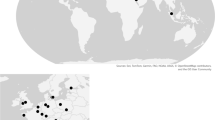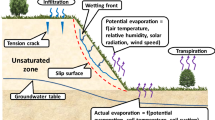Abstract
To characterise the water retention behaviour of fine soils, high suction values are applied. In this range of values, the vapour equilibrium technique is usually used. This paper presents an innovative device, a sorption bench that permits the determination of the water retention curve of soil. With this new testing method, the time required for testing is significantly reduced. In addition, this apparatus enables the thermal conditions of a test to be controlled; thus, the applied suction can be better controlled, and the water retention curve for different temperatures can be determined. Another valuable aspect of the device is the adopted technical solution that permits weighing of the samples inside the desiccators at any time. Consequently, the water content kinetics can be defined without disturbing the drying or wetting processes.







Similar content being viewed by others
References
Baldi G, Hueckel T, Peano A, Pellegrini R (1991) Developments in modelling of thermo-hydro-geomechanical behaviour of Boom Clay and clay-based buffer materials. ISMES, Final report, EUR 13365, vol 1, p 134
Bernier F, Volckaert G, Alonso E, Villar M (1997) Suction-controlled experiments on Boom Clay. Eng Geol 47:325–338
Blatz JA, Cui Y-J, Oldecop L (2008) Vapour equilibrium and osmotic technique for suction control. Geotech Geol Eng 26(6):661–673
Borel R, Cretinon B (1994) Vérification des hygrometers mesurant l’humidité relative avec des solutions salines saturées. Bull BNM 98
Brooks RH, Corey AT (1964) Hydraulic properties of porous media. Colorado State University Hydrology Paper, vol 27, issue no 3
Coll C (2005) Endommagement des roches argileuses et perméabilité induite au voisinage d’ouvrages souterrains, Ph.D. thesis, Université Joseph Fourier, France
Dehandschutter B, Vandycke S, Sintubin M, Vandenberghe N, Gaviglio P, Sizun J-P, Wouters L (2004) Microfabric of fractured Boom Clay at depth: a case study of brittle-ductile transitional clay behaviour. Appl Clay Sci 26:389–401
Fredlund DG, Xing A (1994) Equations for the soil-water characteristic curve. Can Geotech J 31:521–532
Gallipoli D, Wheeler SJ, Karstunen M (2003) Modelling the variation of degree of saturation in a deformable unsaturated soil. Géotechnique 53(1):105–112
Geiser F (1999) Comportement mécanique d’un limon non saturé: étude expérimentale et modélisation constitutive, Ph.D. Thesis, Ecole Polytechnique Fédérale de Lausanne, Switzerland
Greenspan L (1976) Humidity fixed points of binary aqueous saturated solutions. J Res Natl Bureau Stand Phys Chem 81(1):89–96
Head KH (1980) Manual of soil laboratory testing, soil classification and compaction tests, vol 1. Pentech Press, London
Horseman ST, Winter MG, Entwistle DC (1987) Geotechnical characterization of boom clay in relation to the disposal od radioactive waste. Commission of the European Communities, EUR 10987, p 87
McLaughlin CP, Magee TRA (1998) The determination of sorption isotherm and the isosteric heats of sorption for potatoes. J Food Eng 35:267–280
Nuth M, Laloui L (2008) Advances in modelling hysteretic water retention curve in deformable soils. Comput Geotech 35(6):835–844
O’Brien F (1948) The control of humidity by saturated salt solutions. J Sci Instrum 25:73–76
Péron H, Hueckel T, Laloui L (2007) An improved volume measurement for determining soil water retention curves. Geotech Test J 30(1):1–8
Pham HQ, Fredlund DG, Barbour SL (2005) A study of hysteresis models for soil-water characteristic curves. Can Geotech J 42:1548–1568
Ridley AM, Wray WK (1996) Suction measurement: a review of current theory and practices. In: Alonso EE, Delage P (eds) Proceedings of the 1st international conference on unsaturated soils (UNSAT 95), Paris, 1995. Balkema, Rotterdam, The Netherlands, pp 1293–1322
Romero E (1999) Characterization and thermo-hydro-mechanical behaviour of unsaturated Boom clay: an experimental study, Ph.D. thesis, Universitat Politècnica de Catalunya, Barcelona, Spain
Salager S, El Youssoufi MS, Saix C (2008) Temperature effect on hydric behaviour for unsaturated deformable soils. In: Proceedings of the 2nd Int. Conf. on mechanics of unsaturated soils, Weimar, Germany
Salager S, El Youssoufi MS, Saix C (2010) Temperature effect on water retention phenomena in deformable soils—theoretical and experimental aspects. Eur J Soil Sci 61(1):97–107
Sugii T, Yamada K, Kondou T (2002) “Relationship between soil-water characteristic curve and void ratio” unsaturated soils. In: Jucá JFT, de Campos TMP, Marinho FAM (eds) Proceedings of 3rd international conference on unsaturated soils (UNSAT 2002), Recife, Brazil, vol 1. Swets and Zeitlinger, Lisse, pp 209–214
Tang AM (2005) Effet de la température sur le comportement des barrières de confinement, Ph.D. thesis, Ecole Nationnale des Ponts et Chaussées, Paris
Tang A-M, Cui Y-J (2005) Controlling suction by the vapour equilibrium technique at different temperatures and its application in determining the water retention properties of MX80 clay. Can Geotech J 42:287–296
Vanapalli SK, Fredlund DG, Pufahl DE (1999) The influence of soil structure and stress history on the soil-water characteristic of a compacted till. Géotechnique 49(2):143–159
Verbrugge JC, Fleureau JM (2002) Bases expérimentales du comportement des sols non saturés. In: Coussy O, Fleureau JM (eds) Mécanique des sols non saturés. Hermès Science, Paris, pp 69–112
Wexler A, Hasegawa S (1954) Relative humidity-temperature relationships of some saturated salt solutions in the temperature range 0 to 50°C. J Res Natl Bureau Stand 53(1):19–25
Winston PW, Bates DH (1960) Saturated solutions for the control of humidity in biological research. Ecology 41(1):232–237
Zerhouni MI (1991) Rôle de la pression interstitielle négative dans le comportement des sols—application au calcul des routes, Ph.D. Thesis, Ecole Nationale des Ponts et Chaussées, Paris
Author information
Authors and Affiliations
Corresponding author
Rights and permissions
About this article
Cite this article
Salager, S., Rizzi, M. & Laloui, L. An innovative device for determining the soil water retention curve under high suction at different temperatures. Acta Geotech. 6, 135–142 (2011). https://doi.org/10.1007/s11440-011-0141-8
Received:
Accepted:
Published:
Issue Date:
DOI: https://doi.org/10.1007/s11440-011-0141-8




